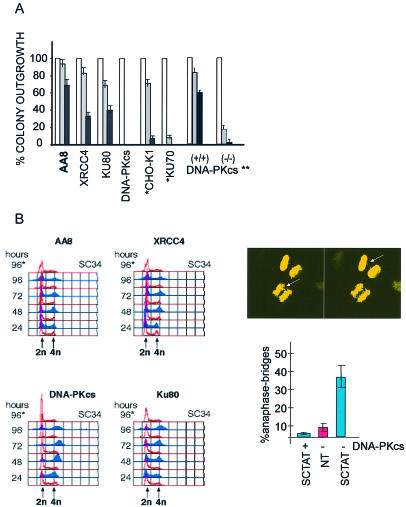Figure 3.
Hypersensitivity of cell lines defective in NHEJ. (A) Colony forming assays of NHEJ mutated CHO cells treated with SCPVU-TAT. Cell lines used are AA8 (parental line), V3 [DNA-PKcs(–/–)], xrss5 [KU80(–/–)] and XR-1 [XRCC4(–/–)], HIS P1.13–11 [KU70(–/–)] (*) and the corresponding parental line CHO-K1 (*). Also included are assays done with human DNA-PKcs (**) mutant cells MO59J [DNA-PKcs minus (–/–)] compared to MO59K [DNA-PKcs plus (+/+)] cells. Various dilutions of the CHO and the human MO59 cells carrying the different NHEJ mutations as indicated were either ‘not treated’ (white bars) or treated with SCPVU-TAT (25 nM, gray bars; 100 nM, black bars) for 24 h; cells were then washed and grown for 7–10 days, stained with GIEMSA and colonies were counted. A summary of the results is shown as histograms and represents the mean from three experiments with standard deviations in the range of 15–20% as indicated. ‘No treatment’ was set equal to 100%. Missing gray and black bars in V3 [DNA-PKcs(–/–)] histograms indicates colony outgrowth below 1%. (B) (left panel) FACS analysis of various NHEJ mutant cell lines after the time periods indicated. Cells were treated with 100 nM SCPVU-TAT (blue histograms) or 100 nM SC34 (red histograms, SC34), or not treated (red histograms) for the time periods as indicated on the right of the histograms and analyzed in FACS analysis as in Figure 2; (B) (right panel, top) Example of an anaphase bridge observed 48 h after SCPVU-TAT treatment of MO59J [DNA-PKcs (–/–)], two different Z layers of the same object are shown; arrows indicate fused chromosomes. (B) (right panel, bottom) Analysis of anaphase bridges in MO59J [(DNA-PKcs (–/–)] and MO59K [(DNA-PKcs (+/+)] cells after 48 h of SCPVU-TAT treatment, cells and conditions as indicated; for each condition, 3 × 50 anaphases were examined by microscopy after DNA staining and results are summarized in ‘% of anaphase-bridges’ with observed standard deviations [SCTAT (blue bars), SCPVU-TAT treated; NT (red bars), not treated].

